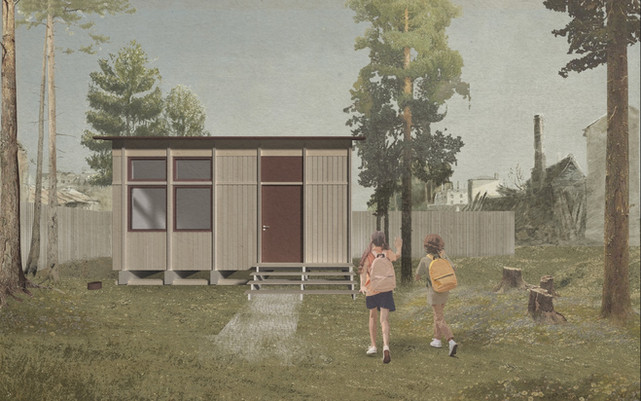Transitional Housing Unit
for Ukraine
Trostyanets, Ukraine
Partners:




Humanitarian architecture is a rather interesting part of the Built Environment as it faces a lot of challenges: urgency, unpredictability, tight budgets, resource scarcity, difficult and even dangerous sites, diverse climate conditions and more. But above all, it is invaluable for the people who need it, people who have suffered disasters triggered by man-made or natural hazards. Unfortunately, very often the needs of the users come second to other criteria like cost. This may lead to units which are culturally and environmentally unfit and ultimately cause more harm than good. PSR’s approach aims to design with the people, for the people. By starting conversations, organising workshops and asking questions, the user's unique needs, wishes, and even fears, can be better understood and thus addressed in the shelters. This ensures acceptance, encourages maintenance and alleviates some of the hardships of displaced populations.
In March 2022 PSR began the design of a Transitional Housing Unit (THU) for Ukrainian internally and externally displaced people returning to rebuild their homes destroyed by war. The design process started with participatory workshops and a survey with the Ukrainian community living in Poland, mapping their housing needs and preferences. Three workshops were conducted with three age groups: children, teenagers and adults. The results of the hands-on workshops have strongly informed the design phase of the unit.

The Unit acts as temporary housing for people, whilst they’re looking for permanent accommodation or their house is being rebuilt. Once that function is no longer needed, the structure can be easily repurposed for a community centre, work space or a cafe. Thus, its lifespan is much longer than that of traditional transitional housing options.
The construction is made of biobased materials. After the inital design phase, a partial prototype was built in Warsaw, which further informed the building process. After carefully evaluating the prototype and getting feedback on the initial design during exhibitions and presentations, changes were made to improve the THU.
In 2023 we started a partnership with the municipality of Trostyanets, a town located in eastern Ukraine. About 1600 people have lost their homes and are currently housed in suboptimal conditions. For that reason we received the request for 2-3 THUs, with the opportunity to produce more units in the future. The building site is located close to sport facilities, so the expected future use of the units is homes for young ukrainian athletes. Each THU can host a family of 4. We have raised enough funds for the implementation of one unit with expected completion date in October 2024. Construction delays occurred due to ongoing conflict in the region.

Our long term ambition for our designs to become as circular as possible. For that reason we evaluate and improve our designs. We implement a Recommendation set and visual evaluation tool for circularity informed design decisions developed specifically for transitional housing units by one of our team members during their MSc thesis. Based on the results we see that the current Design and Manufacturing decisions bring us closer to a circular project, however, we will further develop the Material and Management aspects.









